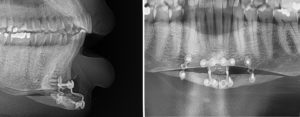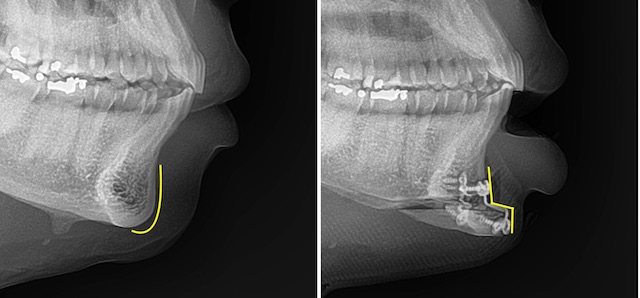Background: The sliding genioplasty is a well known chin reshaping procedure. Unlike its bigger brother, the sagittal split ramus osteotomy done back at the jaw angles, the sliding genioplasty does not affect the occlusion or any movement of the lower jaw. It is an isolated procedure done just on the chin bone at the anterior end of the lower jaw. While it is a procedure that has been done for a long time, it has received more recent notoriety as part of v-line surgery. In jawline reduction/reshaping the chin part of the procedure is done by an inverted t-shaped osteotomy which may involve some degree of chin bone advancement.

This change in chin bone shape may seem like merely an irrelevant geometric observation but it is one that persists after bone healing. While the bone edges may become less sharp after healing much of the stair step shape change remains. This bony alteration has numerous potential implications after a sliding genioplasty including aesthetic deepening of the labiomental fold and scar contracture and chin pad tightness.

The surgical plan to improve her post bony genioplasty symptoms was to performed a wide soft tissue release, removal of the plates and screws and the placement of an interposition fat graft. To avoid a donor site harvest scar on her lower abdomen it was elected to harvest her buccal fat pads. Given her prior cheekbone reduction osteotomies it was unclear if they were still present.

The bony step off of the sliding genioplasty is a natural result of the procedure. It usually does not cause any problems but the unnatural shape of the bone can serve as an area for soft tissue collapse and scar contracture. This may become magnified in the more extensive t-shaped bony genioplasty used in v-line surgery. Its treatment is to release the scar contracture and place an interposition material (graft or implant) to prevent its recurrence. A solid fat graft is always a good choice to use in any release of scar contracture. But when a fat graft is not available an implant can be used with precautions to prevent infection.
Case Highlights:
1) Tightness of the chin can occur after a sliding genioplasty to v-line surgery.
2) Scar contracture can occur into the bony step off of a sliding genioplasty due to the alteration of the natural convexity of the chin bone.
3) Release of such contracture must be accompanied by some form of interpositional graft or implant to prevent recurrence of the symptoms.
Dr. Barry Eppley
Indianapolis, Indiana





